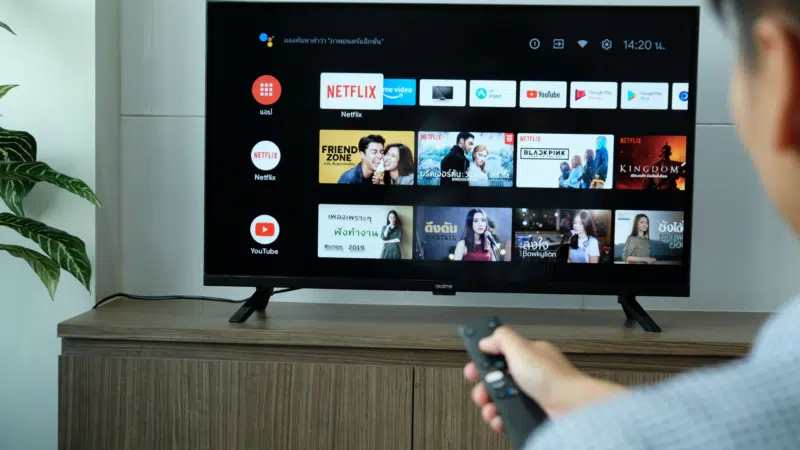One of the most unique companies in the TV advertising industry is Telly, a US startup that provides consumers with a free dual-screen TV with commercials broadcast on the second screen.
Today, the firm makes its debut at the IAB NewFronts in New York, announcing a new suite of ad products that include T-commerce capabilities and synchronized ad formats.
One of the challenges of introducing shoppable commercials to television has been convincing consumers to shop for things while watching TV. Tech companies have attempted to simplify the customer trip by moving the purchasing functionality to a second screen, which has typically been a mobile device. The difference with Telly is that it incorporates a second screen inside the TV itself, allowing users to interact with commercials using their remote control without interfering with the material they are watching.
READ MORE: Advertisers Look To CTV And Social Video In The Lead-Up To Cookie Deprecation

According to the corporation, the new T-Commerce ad type would enable one-click shopping on the Telly interface. For example, if a Pizza Hut ad appears on the main screen during an NBA game, viewers can use the remote to bring up a shoppable ad on the smaller screen, where they can order a pizza. Telly subscribers have also registered their home address and credit card information, so no further input is required, and the second screen then displays a countdown to their delivery.
The company touts Telly’s built-in user data as a crucial difference. To qualify for free TV, consumers must answer 120 questions about their household, including income and number of residents. In terms of advertising, this allows for one-on-one customer targeting rather than the panel-based modelling that is commonly employed in television. And the company claims that this first-party data is driving money from social media into CTV.
READ MORE: With Marketing Budgets Under Pressure, CTV Measurement Is More Important Than Ever
“We are tapping into search and social budgets, budgets that would have traditionally gone to Facebook or Instagram, because we have the same type of data, insights and actionability that would drive the ads on those digital platforms – we can now drive them on TV,” Dallas Lawrence, the chief strategy officer at Telly, says. “So if you want to reach millennial moms in the market for a car today, who want to buy an electric vehicle, who want to have a car payment of less than $400 a month, who have two kids, I don’t have to model that, I’ll give you that exact household, and you can have a one-to-one advertising relationship with that household.”

The Free Model
Given the small market segment that uses the free TVs, this one-of-a-kind business model poses scaling concerns. However, Dallas Lawrence believes that when the TV is free, scaling should take care of itself. “Nothing scales faster than free,” he said. “I think the finest example is TikTok, which reached 100 million subscribers in nine months. ChatGPT surpassed 100 million users in two weeks. Free is universal on a large scale. So our free model is what will allow us to achieve rapid market penetration.”
READ MORE: The Dangers Of Overcomplicating Measurement In CTV And Overpromising On Targeting
The company analyzed the data it collected from the first 400,000 users and discovered that they modeled the US Census on geographic distribution, gender, and ethnicity, implying that the user base reflects the larger population. However, they are also younger (two-thirds of Telly users are under the age of 45) and earn more than the US average. According to the business, average Telly usage is more than double that of traditional TV, with households watching TV for more than 6.5 hours per day. This includes Telly’s “beyond TV” capabilities that may be added to the bottom screen, such as news, sports, and weather widgets, a Zoom camera, motion-tracking fitness, and voice assistants.

The company does not disclose the number of TVs currently in use, despite last year’s original announcement of 500,000 devices made by an unidentified major TV manufacturer. However, Lawrence points out that high usage rates encouraged Telly to begin its advertising company ahead of schedule, and it now has connectors with all of the big programmatic companies. Today, the firm will also unveil new programmatic integrations with Index Exchange and Madhive, additional relationships with media agencies, and the launch of Vevo’s ad-supported music video app.
READ MORE: NBCU Wants CTV To Be A Channel For Shows. Is Adobe Able To Help It Get There?
“There’s a reason why digital advertising has been growing for decades straight: it works,” says Lawrence. “There’s a reason why TV has been unavailable for the same period. So, when you combine the finest of the internet world with the creative platform of a 55-inch wall-mounted screen, as well as a great amount of personalised data that people share with us, you can create a considerably richer advertising experience.”

Double problem.
Telly is also agnostic about streaming operating systems, allowing customers to connect their own device, such as an Amazon Fire Stick or Apple TV. The company’s ACR technology can then read the dongle to determine what consumers are watching and track viewing across streaming, linear, and gaming. The company licenses this data, emphasizing the value it provides to advertising. This includes co-viewing data, which is collected using a built-in 3mm wave sensor to determine how many people are within 25 feet of the TV.
Telly’s ability to identify adverts on the primary screen allows him to synchronise ads on the second screen. One of the new ad offerings is Telly’s dual-screen takeover format, which employs this technology. For example, when insurance company State Farm airs a national ad on NBC, Telly displays a regionalized, addressable ad on the bottom screen, prompting consumers to click their remote to schedule an appointment with their local State Farm agent. The style also allows for synchronised conquest commercials, which allow a business to advertise on the second screen as their competitor’s ad appears on the main screen.
“One leading automotive advertiser has told us anytime they see their competitor’s car commercial, they want to launch a conquesting ad in the bottom-right hand corner that says, ‘This is the number one new car in America, not this one!'” Lawrence goes on to say. “The marrying of those two screens, and the technology and the data behind it to have a different advertising experience is why we’re seeing new, different dollars come back into television.”
Radiant TV, offering to elevate your entertainment game! Movies, TV series, exclusive interviews, music, and more—download now on various devices, including iPhones, Androids, smart TVs, Apple TV, Fire Stick, and more.


